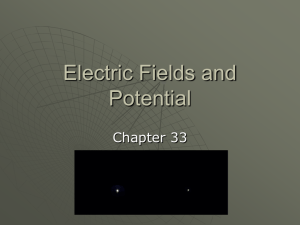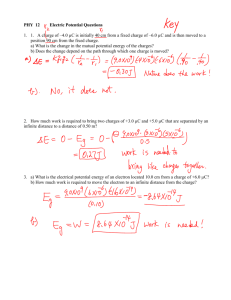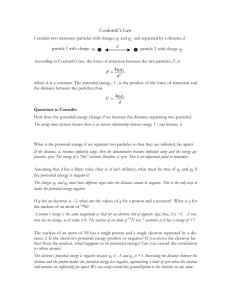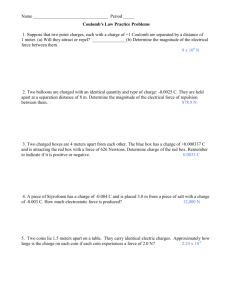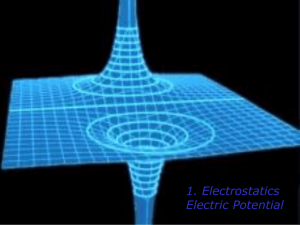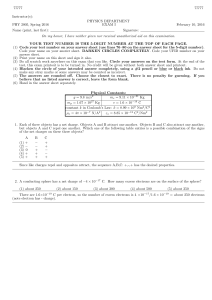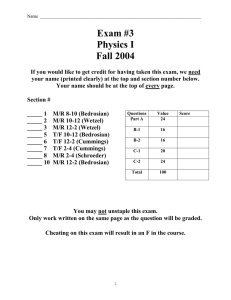77777 Instructor(s): PHYSICS DEPARTMENT PHY 2005, Spring 2007
advertisement
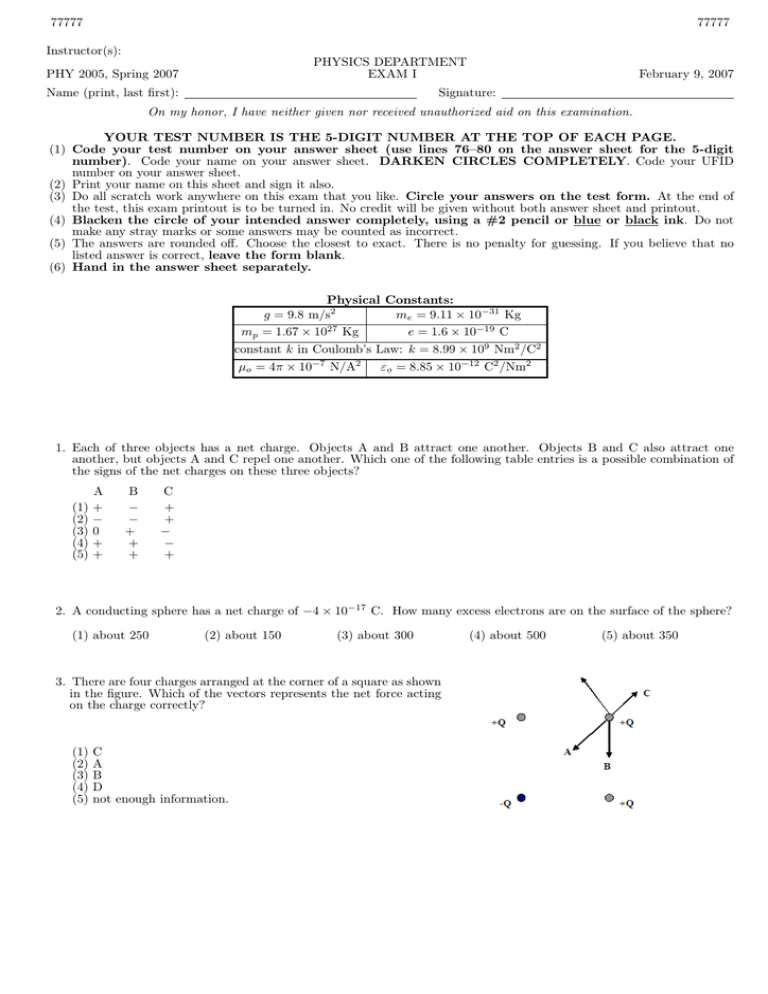
77777 77777 Instructor(s): PHYSICS DEPARTMENT EXAM I PHY 2005, Spring 2007 Name (print, last first): February 9, 2007 Signature: On my honor, I have neither given nor received unauthorized aid on this examination. YOUR TEST NUMBER IS THE 5-DIGIT NUMBER AT THE TOP OF EACH PAGE. (1) Code your test number on your answer sheet (use lines 76–80 on the answer sheet for the 5-digit number). Code your name on your answer sheet. DARKEN CIRCLES COMPLETELY. Code your UFID number on your answer sheet. (2) Print your name on this sheet and sign it also. (3) Do all scratch work anywhere on this exam that you like. Circle your answers on the test form. At the end of the test, this exam printout is to be turned in. No credit will be given without both answer sheet and printout. (4) Blacken the circle of your intended answer completely, using a #2 pencil or blue or black ink. Do not make any stray marks or some answers may be counted as incorrect. (5) The answers are rounded off. Choose the closest to exact. There is no penalty for guessing. If you believe that no listed answer is correct, leave the form blank. (6) Hand in the answer sheet separately. Physical Constants: g = 9.8 m/s2 me = 9.11 × 10−31 Kg mp = 1.67 × 1027 Kg e = 1.6 × 10−19 C constant k in Coulomb’s Law: k = 8.99 × 109 Nm2 /C2 µo = 4π × 10−7 N/A2 εo = 8.85 × 10−12 C2 /Nm2 1. Each of three objects has a net charge. Objects A and B attract one another. Objects B and C also attract one another, but objects A and C repel one another. Which one of the following table entries is a possible combination of the signs of the net charges on these three objects? (1) (2) (3) (4) (5) A + − 0 + + B − − + + + C + + − − + 2. A conducting sphere has a net charge of −4 × 10−17 C. How many excess electrons are on the surface of the sphere? (1) about 250 (2) about 150 (3) about 300 3. There are four charges arranged at the corner of a square as shown in the figure. Which of the vectors represents the net force acting on the charge correctly? (1) (2) (3) (4) (5) C A B D not enough information. (4) about 500 (5) about 350 77777 77777 4. Two small identical metal spheres carry charges of +1.3µC and −0.5µC and are 5.0 m apart. Now the spheres are touched together and again separated to 5.0 m. What force does one exert on the other? (in N) (1) (2) (3) (4) (5) repulsive 5.75 × 10−5 attractive 2.34 × 10−4 repulsive 2.86 × 10−4 attractive 8.25 × 10−4 attractive 1.24 × 10−5 5. An electron with unknown kinetic energy is brought to rest as it falls through a potential 80 V. What was its initial kinetic energy? (in joules) (1) 1.3 × 10−17 (2) 4.8 × 10−18 (3) 60 (4) 0 (5) 30 6. A hydrogen atom is composed of a nucleus containing a single proton (+e), about which a single electron (-e) orbits. Let’s assume that the electron is making a uniform circular motion with a radius 5.3 × 10−11 m. What is the speed of the electron orbiting? (in m/s) (1) 2.18 × 106 (2) 7.19 × 106 (3) 3.10 × 108 (4) 1.56 × 104 (5) 4.20 × 104 7. Two particles of the same mass carry charges +2Q and –Q, respectively. They are shot into a region that contains a uniform electric field as shown. The particles have the same initial velocities in the positive x direction. The lines, numbered 1 through 5, indicate possible paths for the particles. If the electric field points in the negative y direction, what will be the resulting paths for these particles? (1) (2) (3) (4) (5) path path path path path 5 4 1 2 3 for for for for for +2Q +2Q +2Q +2Q both and path and path and path and path charges 2 2 4 4 for for for for –Q –Q –Q –Q 8. A 5-A current is maintained in a simple circuit with a total resistance of 200 Ω. What net charge passes through any point in the circuit during a 1-minute interval? (in C) (1) 300 (2) 1000 (3) 60000 (4) 12000 (5) 157 9. Reduce the resistors between A and B into a single equivalent resistor. (in Ω) (1) 6.8 (2) 14.0 (3) 9.7 (4) 11.2 (5) 16.0 77777 77777 10. Using Kirchoff’s rules for junctions and loops, the following equations are set to solve the circuit shown in the figure. Choose one equation which describes the circuit incorrectly. (1) 7I2 + 6I1 = 9 (2) 7I2 + 10I3 = 6 (3) 6I1 + 10I3 = 3 (4) 7I2 − 6I1 = 3 (5) I1 + I2 = I3 11. Two identical light bulbs (A and B) are connected as shown in the figure. Each light bulb produces 14.4 W of power. What is the resistance of the bulb? (in Ω) (1) 10 (2) 14.4 (3) 57.6 (4) 1.2 (5) 144 12. A uniform electric field is set between two conducting plates as shown in the figure. An electron and a proton are released from their initial positions as indicated in the figure. Which of the following statements are wrong? (A) Both electron and proton will move toward the plate in the far side. (B) Both electron and proton will move in the direction that the electric potential decreases. (C) During the motion, the potential energy of the electron will increase. (D) During the motion, the potential energy of the proton will decrease. (E) During the motion, the kinetic energy of the electron and proton will increase. (1) B, C (2) A, B, C (3) D, E (4) A, C (5) C, D, E

